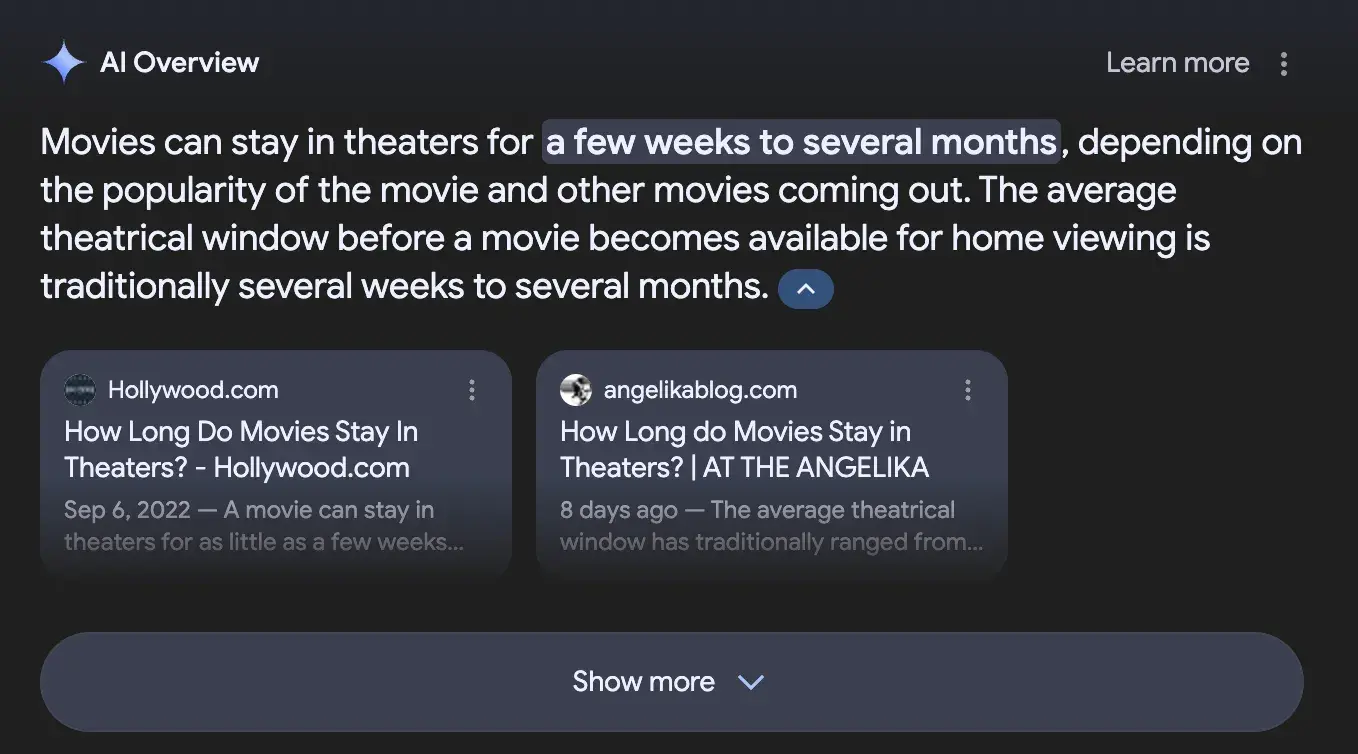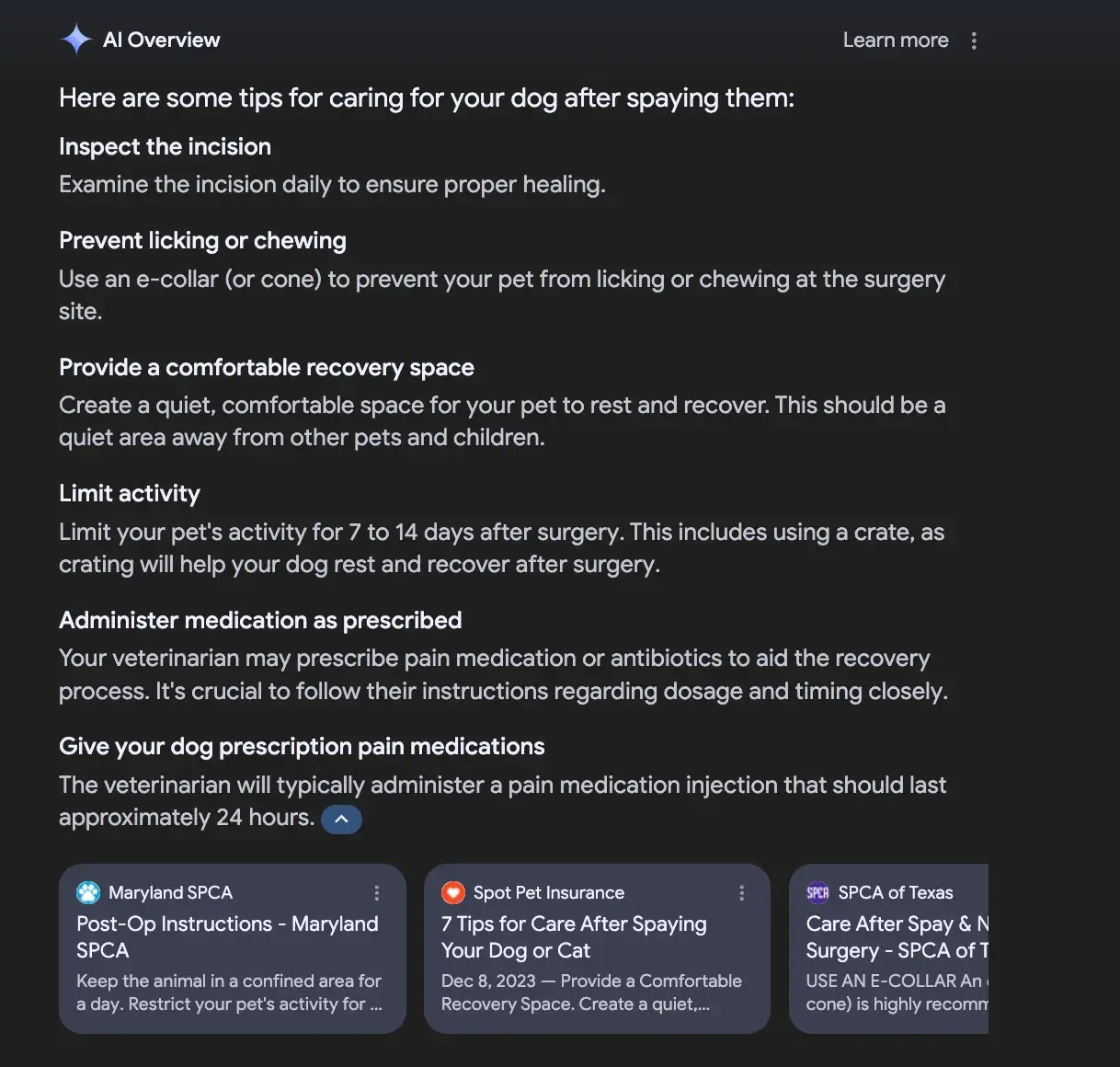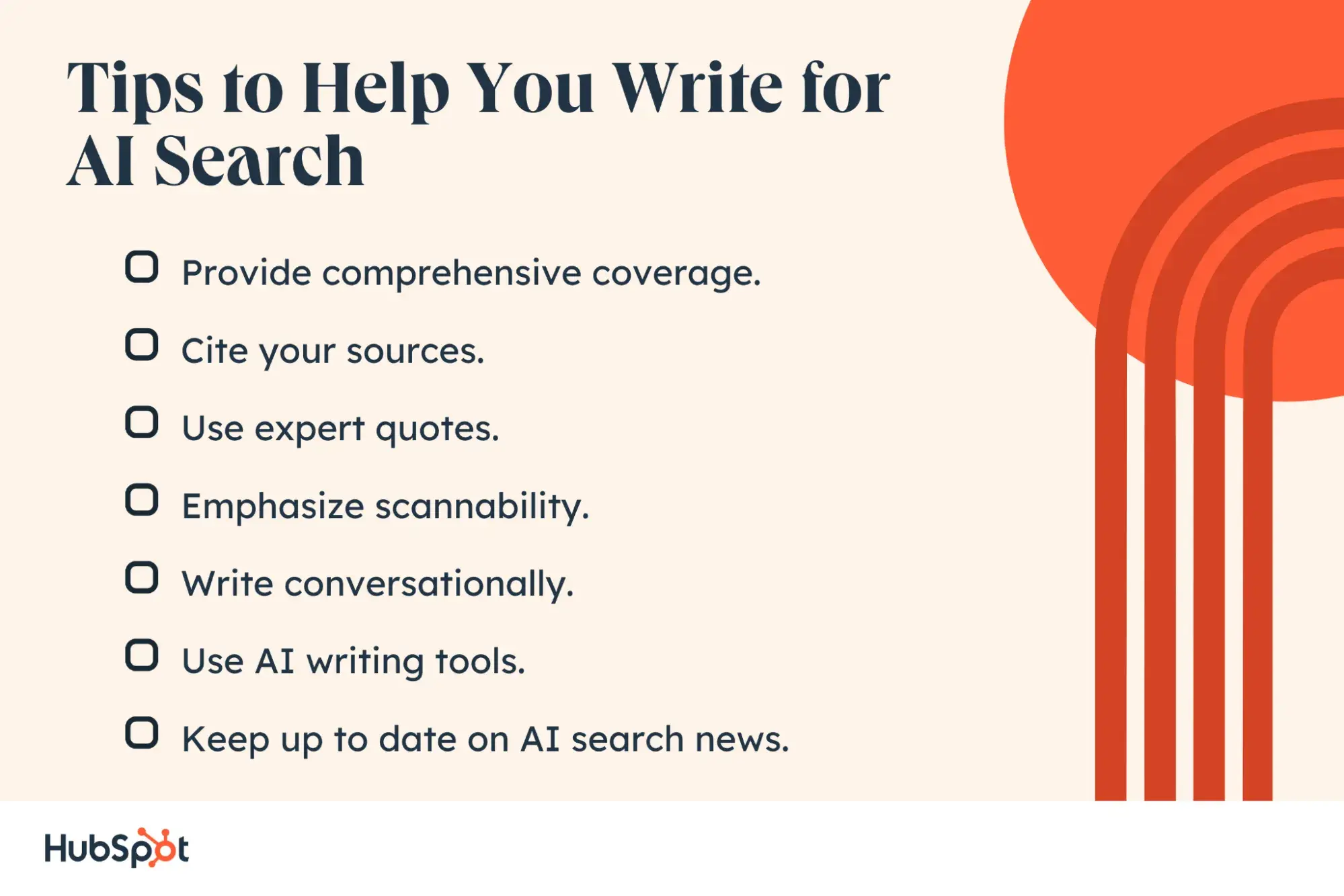There’s no doubt that in the last few months, you’ve run into Google’s new AI search tool. Often, the tool provides a helpful summary (though sometimes it’s laughably wrong).
There’s no doubt that in the last few months, you’ve run into Google’s new AI search tool. Often, the tool provides a helpful summary (though sometimes it’s laughably wrong).
While the tools themselves are evolving every day, it seems generative AI search engines aren’t going anywhere. Since Google launched its AI search, it’s already made leaps in relevance and accuracy.
I’m a big fan of not having to scroll through a page of results to find a quick answer, so I’m excited to see how it continues to evolve.
But as a writer, I’m curious to discover what this will mean for the future of digital content. How will this affect the type of work we do, and how will we need to adapt our writing for AI-driven search?
In this article, we’ll explore the insights we already have about writing for generative AI and raise questions we still need answered.
Table of Contents
How AI Search Has Changed Content Marketing
1. New Information Retrieval
AI-powered generative engines have majorly shifted how users are retrieving the information they’re searching for.
Instead of providing sources for the user to read, generative engines are providing summaries to answer questions in less time.
Recently, I was trying to plan a movie date with a friend to see A Quiet Place: Day One. She was about to leave on vacation, and I wanted to see if the movie would be in theaters when she got back.
I searched “how long are movies usually in theaters.”
I got an answer without clicking on a single page.

2. Less Spam
Earlier this year, major search engines like Google started cracking down on what they considered spam or unoriginal content — many of which were AI-generated.
AI search engines don’t respond well to spammy content and, instead, are looking for high authority, highly structured articles that the bots can easily scan.
As a result, it seems that quality is above quantity when it comes to what’s most important with your content (though many argue that was already the case).
Let’s talk about one of my favorite examples: recipe blogs.
In the past, if I wanted to find a pad thai recipe through Google, a lengthy article using the phrase “pad thai recipe” dozens of times would rank highest.
I’d scroll through long personal anecdotes I didn’t care about with no tips for actually cooking the dish.
Now, the top recipe is from Recipe Tin.
I still have to scroll before getting to the recipe. However, the content focuses on genuinely helpful tips. Nagi, the writer, discusses what makes pad thai authentic, her brand recommendations for ingredients, and techniques.
This information helps me cook the dish better.
I don’t have to parse through spammy content. I get real tips that I know came from a human.

And to clarify: This doesn’t mean you shouldn’t use AI to support your content creation. It just means you need to make sure the content is beneficial to readers.
3. Lower Web Traffic
As AI-generated answers start popping up on search engines, websites have seen lower levels of web traffic overall. Top-ranked websites have seen traffic dips as significant as 10%.
This makes sense, given that many users are stopping at the summary instead of proceeding on. This adjustment means the goal of content might not be to rank highly but, instead, to be used by AI and cited in summaries.
I’m not immune to this, even as a content creator. I considered running a half marathon and wanted to see what a training plan might be.
I could Google to see what experts suggest. Instead, I shared a little bit about my skill level and constraints. Then ChatGPT made me a plan.
That was an easy experience that took way less time than searching for an answer.

4. A change in traffic source.
The above point has a bit of nuance. Most content can expect a dip in traffic, but for content that’s highly visible to large language models (LLMs), you could see an increase in engagement by upwards of 40%.
That’s because the goal of writing for AI search is to be cited as a source. When you’re cited in a summary on Google AI Search, users can easily click on your content to learn more.
My HubSpot editor, Kaitln Milliken, recently had her dog spayed and directly benefitted from AI search. She looked up “how do I take care of my dog after she’s spayed.”

“The AI overview had some helpful tips out the gate, but I wanted to learn more,” Milliken says. “I clicked on the articles in the overview first — partially because it was easy, but also because I trusted that these sources had authority.”
5. De-emphasis on SEO.
What makes an article great for search engines is a bit different than what makes an article great for AI bots.
Whereas SEO is focused on keywords, backlinks, and searchability, generative engine optimization (GEO) emphasizes highly structured articles with lots of sources. This guide on GEO can be a helpful resource as you learn the differences.
How to Write for AI Search
Now that you understand the way AI search has changed the content landscape, let’s look at a step-by-step guide for writing for AI search.
I also asked Kaitlin Milliken, who assigned hundreds of articles a year from the HubSpot blog, for her perspective.

Step 1. Find original ideas with high search traffic.
If I’m tasked with writing a blog and I don’t receive a brief, I’ll start by trying to find an original idea around a topic.
In an ideal world, I’d discover a topic with high search traffic and low competition, but often, I settle for making sure that there’s plenty of traffic driven to the topic.
If I receive a brief and the topic isn’t original, I try to find a unique spin on it. Is there a way I can introduce new information here? Can I tie together two topics that haven’t been related to one another before?
Milliken says that today’s search landscape focuses on EEAT, or expertise, experience, authority, and trustworthiness.
While AI can give general best practices, the content that performs best has insight that can only be learned through lived, human experience.
“We know what search terms people want to know, so that’s always on our assignment docket. However, I need the writer to bring a unique, trustworthy perspective to the piece,” she says.
She describes a hypothetical blog post about solving customer service.
“Let’s say you’re the writer and you work in customer service. What’s the de-escalation tip that you use regularly? Then, give me an anecdote about why it works. A bot can’t do that. That’s what readers actually want,” Milliken says.
Step 2. Research, research, research.
Then, I start by digging into research. I’ll focus on finding primary sources with statistics and data that add credibility to my piece.
You can’t always control the ideas you’re writing about, but you can make sure there’s new and fresh information in it to set your article above the rest and provide a comprehensive answer to AI search bots.
“At HubSpot, we’ve noticed that original data from surveys we conduct rank well in our search landscape. We want our writers to use this data plus whatever the latest data online might be. That bolsters trustworthiness, which reads well in AI search,” Milliken says.
Step 3. Organize your content clearly.
The key to writing for AI search is a great structure. When I research first, I can organize my content clearly without having to go back and rewrite.
I’ll start by identifying H2s and then find spots where I can use lists. Often, there are parts of the article that lend themselves to lists, so I take some time to organize the list items before I start writing.
Want an example? Take a look at the article you’re reading. I have subheadings and organized lists throughout.
Step 4. Ask experts.
A significant way to set yourself apart from AI bots that are scanning your content is by including novel, expert information. This is a best practice for SEO, too, and it helps to boost your article’s credibility.
Send some emails to experts asking for their opinions, tips, or advice. Your readers will love hearing directly from folks with deep knowledge of the topic they’re reading about, and AI bots will be more likely to cite your content.
That’s part of the reason I asked Milliken to share her insights for this piece.
Step 5. Use unique and clear language.
Finally, avoid literary clichés and overused words. Instead, focus on straightforward language.
This is an important editing step, too — cut out all the fluff and unnecessary complexity. AI engines favor content that is both unique and easy to understand. Clear messaging makes it easier for them to generate solid summaries.
Step 6. Measure your content’s performance.
HubSpot is making it easy to see how your content is performing with the AI Search Grader microapp. This is one of the first tools on the market that can help you track how your content is performing on AI search engines.
7 Helpful Tips on Writing for AI Search
A lot of AI search best practices are still emerging, but some rules of thumb for AI search writing are becoming clear. Here are seven tips for writing for AI search.
1. Provide comprehensive coverage.
Generative engines prefer content that offers a comprehensive overview and answers potential follow-up questions, so take time to cover topics thoroughly and from multiple angles.
Keep in mind what the AI bot is trying to do — find a way to fully answer the user’s query with a useful and relevant summary. The more comprehensive you are in your content, the easier it is for the AI bot to do its job.
2. Cite your sources.
Credibility seems to be a major determinant of what AI bots are using to fuel their responses, so citing your sources is an absolute must.
Use primary sources and statistics whenever possible, and make sure to include links to where the information came from.
3. Lean on industry experts.
Novel, human information seems to be frequently picked up by AI bots, so be sure to incorporate expert opinions and advice into your content.
Google isn’t penalizing AI-written content, but it is penalizing content that isn’t rich in information. Use the expertise of SMEs to make sure your content stands out to both readers and AI bots.
4. Emphasize scannability.
Structure and scannability seem to be two of the most important factors in whether or not your content is optimized for AI search. That means you need to:
- Incorporate lists whenever possible
- Limit large chunks of text
- Prioritize H2s and H3s that guide the reader through the text
It’s also suspected that AI bots have a few preferred patterns of text. This isn’t verified yet, but I recommend experimenting with various formats and structures.
5. Write conversationally
AI summaries are written conversationally, so it’s helpful to the bot if its original sources are written conversationally, too.
Avoid industry jargon whenever possible and keep your writing to a 7th-grade reading level in most cases. You want your content to be easy to read for both your users and AI bots.
Leigh McKenzie, an SEO expert, shares his insights on this tip.
“Writing in a more conversational manner is becoming increasingly valuable. In an era where automated content can often sound robotic, we crave authenticity,” McKenzie says.
“Content that includes anecdotes, personal statements, and real-life problem-solving resonates more with readers, and I believe we will see a continued shift towards this style.”
6. Use AI writing tools
Writing tools can help you reach greater visibility through SEO and GEO.
Tracking your metrics can show you if your content is being used by generating engines, and microapps can suggest improvements for search engine visibility and even grade GEO.
7. Keep up to date on AI search information
AI search best practices are constantly evolving. While these recommendations are emerging as ways to improve your AI search performance, it’s best to keep an eye on AI search engine updates.
McKenzie stats that keeping up with new information on AI search is incredibly important when it comes to keeping your digital content up-to-date.
“From my experience, the biggest takeaway in navigating the generative SEO landscape is the importance of adaptability. SEO is not static, and being flexible and open to new strategies is crucial for success,” McKenzie says.

Writing for Bots and for Humans
Whenever there’s a shift in the digital content landscape, I get excited. I love learning new things and, with something as game-changing as AI, there’s a lot to discover.
Test formats. Play with expert quotes. Use different kinds of structures. Now’s the time to get really creative and see what works.
AI changes so much every day, so I’m excited to see how digital content changes in the next year or two. Will we still be using SERPs? Will we only be searching through AI engines?
I’m not sure — but I’m excited to see what happens.
![]()



![Download Now: 5 Essential Resources for Using ChatGPT at Work [Free Kit]](https://no-cache.hubspot.com/cta/default/53/540f7c99-d8e9-4c6a-9a5e-7171f8876ae9.png)
